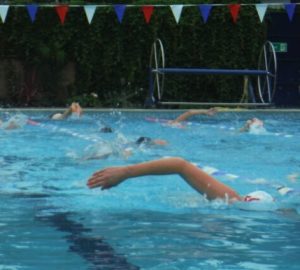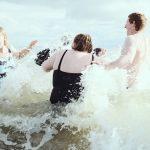
Into the blue
Glowing blue along the entrance to Brixton Recreation Centre in London is a series of cyanotypes of swimmers by artist Rosalind Hobley. We spoke to Rosalind about how she created her work using this historic medium, and the joy she finds in the shared passion of the swimming community
Glowing blue along the walkway and entrance to Brixton Recreation Centre in London is a series of cyanotypes of swimmers by artist Rosalind Hobley. Rosalind began this series during lockdown – to recreate that feeling of pleasure and freedom of being immersed in water, when the nation’s swimming pools were closed. We spoke to Rosalind about how she created her cyanotypes, and the joy she finds in the shared passion of the swimming community.
Rosalind, what is a cyanotype, and what’s the process of creating one?
Cyanotype is an early photographic process, and gives a unique blue coloured print. One of the earliest people to have done it was Anna Atkins. She made cyanotypes of plants and seaweed in the 1840s – they’re really beautiful.
Each of my cyanotypes is made by hand, coating cotton rag paper with a light sensitive solution (the key ingredient is iron salts) and exposing it to UV light, usually the sun. I started off using sunlight because I began making this series during lockdown, on my balcony in London. I’d then take it down to my bathroom and rinse it with water, and the yellow hues would instantly change to blue. This blue darkens over the next 24 hours into a deep Prussian blue.

What drew you to this medium for your Swimmers series?
My training was in figurative art and sculpture, and my photographs are strongly influenced by classical art. I love the sculptural qualities of the Swimmers, and that is especially brought out by the tonality of the cyanotypes. The print of Mitchel reaching down to the bottom of the pool (pictured below left) reminds me of a Michaelangelo sculpture.
The ripples and distortion of the water create a unique 3D feel to the images, which I think works particularly well with cyanotype. It is also in some ways a very painterly process.
The fact that they are deep blue has connotations with water, and makes the images more abstract.


What inspired you to engage with swimmers as a subject for your images?
I’m not a trained swimmer, but I’ve loved swimming since my early 20s. It’s my happy place. I wanted to capture what I see when I go for my swims in an urban pool – the people, the tiles, the swimhats and goggles. I also love it when you see the sun shining through the ripples – it reminds me of David Hockney’s swimming pool paintings.
Were there any challenges or difficulties with capturing the images?
Having to line up the goggles with the double viewfinder to be able to see what I was doing was a bit of a challenge. I did a lot dance photography some years ago and the ability to work fast and and almost instinctively to capture the movement was perfect training for the swimming photos. Because I swim a lot it wasn’t too hard to breath-hold and capture the images.
What kit did you use?
I used my big old Nikon D3s with 20mm lens and an Outex housing. I had to wrestle the camera into the housing but it was all pretty straightforward. I found Outex Europe to be very helpful with their advice.
Did the swimmers require a lot of direction?
Generally I let the swimmers do their own thing. Cherry – the woman in the leopard print costume – she was just amazing. She just got in the water and did these dance movements, which resulted in some of my best pictures ever.


How do you feel about how they’ve turned out? Anything unexpected?
Considering the wrangling with the kit, and the restrictions of being underwater, I am often surprised how good the results are when I finally get to see the images from the shoots. Similarly, with the Lightboxes project I was completely wowed when I saw the final installation. I am very grateful to Richard at Photofusion, who transformed my cyanotype prints into beautiful backlit transparencies that are perfectly faithful to the originals.
Do you have a favourite piece?
I like them all in really different ways. I really like the ones where the water is totally dark and the swimmer can look almost abstract, and I also like the ones where you can clearly see the pool and the person. A bit of both really.


Is there another subject you’re drawn to for a future project?
I do have another swimmers project, which is a little bit different. I’m going to leave that as a bit of a mystery at the moment.
Are you an outdoor swimmer yourself?
I’d love to but swimming outdoors gives me hives (I am literally allergic to the cold), so I stick with the indoor pools. A lot of outdoor swimmers find my work on my website via Instagram – there was one woman who bought one of my prints during lockdown because she really missed outdoor swimming. I really enjoy that feeling of shared passion among the swimming community. This project is about sharing that love, and encouraging others to swim.
The Swimmer series was created in collaboration with Photofusion, Active Lambeth and Lambeth Council.
Rosalind’s Swimmer series will be on display at Brixton Recreation Centre in London until September. Selected Swimmer prints are available from her website, rosalindhobley.com








